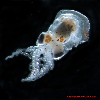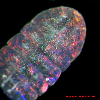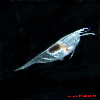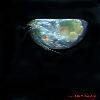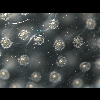Press Room
| Deep-Sea Creatures | Gelatinous Zooplankton |
| New Species | Other types of Zooplankton |
| Swimming Molluscs | People and Gear |
| Crustacea | Video Clips |
* Also take a look at the Galathea3 slide show (NW Australia). All images are available at higher resolution, by Russ Hopcroft.
Terms of Use: All pictures on this website can be used for educational purposes with reference to this site (www.cmarz.org) and the photographer. To obtain high resolution images, please contact either the webmaster or the photographer.
.jpg) |
Euaugaptilus ractus
(copepod) Sargasso Sea Cruise (10-30 April 2006) |
.jpg) |
Gaussia
princeps (copepod) Sargasso Sea Cruise (10-30 April 2006) |
.jpg) |
Lucicutia
aurita (copeods) Sargasso Sea Cruise (10-30 April 2006) |
.jpg) |
Valdiviella insignis
(copepod), This crustacean lives very deep, > 1000m. Female with purple egg sacs. Sargasso Sea Cruise (10-30 April 2006) |
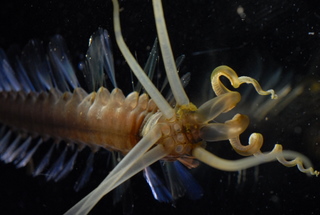 |
Squid worm, collected in the Celebes Sea at about 2800 m depth using the “Global Explorer” ROV in 2007. It is considered a new genus and species, in a newly described family of swimming polychaetes (Osborn et al. 2009, Science 325:964) photo by L. Madin, Woods Hole Oceanographic Inst. (WHOI) |
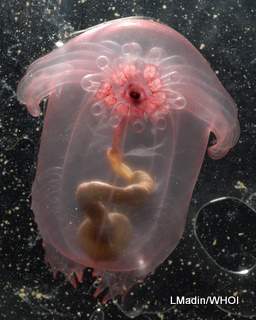 |
Enypniastes sp. (holothurian), a transparent pink sea cucumber discovered in the Celebes Sea may be a new species but until a specialist can take a look at an actual specimen we can't say for sure if it's new. The internal brown tube is its gut. photo by L. Madin, Woods Hole Oceanographic Inst. (WHOI) |
 |
Athorybia (siphonophore - colonial jelly) photo by L. Madin, Woods Hole Oceanographic Inst. (WHOI) Sargasso Sea Cruise (10-30 April 2006) |
 |
Rosacea (siphonophore - colonial jelly) Sargasso Sea Cruise (10-30 April 2006) |
 |
Rosacea_tentacles (siphonophore - colonial jelly) Long tentacles extend a meter away from the main body and contract when disturbed by potential food items. The beads are stinging cells that immobilize and kill the prey. Sargasso Sea Cruise (10-30 April 2006) |
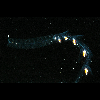 |
Halistemma (siphonophore - colonial jelly) The tiny float (far left) give this long colonial organism a sense of up and down. Sargasso Sea Cruise (10-30 April 2006) |
 |
Rhizophysa (siphonophore - colonial jelly) Close-up of float containing a bubble of air. Sargasso Sea Cruise (10-30 April 2006) |
 |
Chelophyes appendiculata (siphonophore) photo by R. Hopcroft, University of Alaska - Fairbanks (UAF) Sargasso Sea Cruise (10-30 April 2006) |
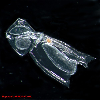 |
Abylopsis tetragona (siphonophore) photo by R. Hopcroft, University of Alaska - Fairbanks (UAF) Sargasso Sea Cruise (10-30 April 2006) |
 |
Thalassocalyce (ctenophone - comb jelly) Irridescent combs beat in a cascade of action, allowing the comb jelly to swim. photo by L. Madin, Woods Hole Oceanographic Inst. (WHOI) Sargasso Sea Cruise (10-30 April 2006) |
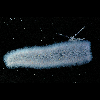 |
Pyrosoma_with_radiolarian (pelagic tunicate) Another colonial organism made up of hundreds of 'zooids'. Tiny specks surrounding the pyrosome are single-celled radiolaria upon which it's feeding. photo by L. Madin, Woods Hole Oceanographic Inst. (WHOI) Sargasso Sea Cruise (10-30 April 2006) |
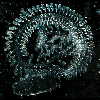 |
Dolioletta (pelagic tunicate - adult with young) The large transparent 'mother' has released a chain of identical young. photo by L. Madin, Woods Hole Oceanographic Inst. (WHOI) Sargasso Sea Cruise (10-30 April 2006) |
 |
Salpa_maxima (pelagic tunicate) This chain of salps have brilliant red guts from eating red plankton. photo by L. Madin, Woods Hole Oceanographic Inst. (WHOI) Sargasso Sea Cruise (10-30 April 2006) |
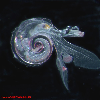 |
Atlanta peroni (pteropod) Shiny black eyes photo by R. Hopcroft, University of Alaska - Fairbanks (UAF) Sargasso Sea Cruise (10-30 April 2006) |
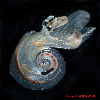 |
Atlanta peroni (pteropod ) photo by R. Hopcroft, University of Alaska - Fairbanks (UAF) Sargasso Sea Cruise (10-30 April 2006) |
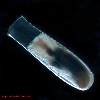 |
Cuvierina columnella (pteropod ) R. Hopcroft, University of Alaska - Fairbanks, (UAF)
Sargasso Sea Cruise (10-30 April 2006) |
 |
Cuvierina columnella, wings out (pteropod) photo by R. Hopcroft, University of Alaska - Fairbanks (UAF) Sargasso Sea Cruise (10-30 April 2006) |
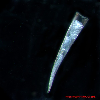 |
Creseis chierchiae (pteropod) photo by R. Hopcroft, University of Alaska - Fairbanks (UAF) Sargasso Sea Cruise (10-30 April 2006) |
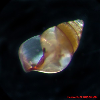 |
Limacina bulimoides (pteropod) photo by R. Hopcroft, University of Alaska - Fairbanks (UAF) Sargasso Sea Cruise (10-30 April 2006) |
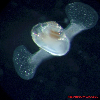 |
Limacina leseuri (pteropod) Wings are out for swimming. photo by R. Hopcroft, University of Alaska - Fairbanks (UAF) Sargasso Sea Cruise (10-30 April 2006) |
 |
Diacria trispinosa (pteropod) photo by R. Hopcroft, University of Alaska - Fairbanks (UAF) Sargasso Sea Cruise (10-30 April 2006) |
 |
Pneumodermopsis macrochira (naked pteropod) This type has no shell. The mouth is at the upper left, gut central and white eggs tucked near the back of the body, lower right. photo by R. Hopcroft, University of Alaska - Fairbanks (UAF) Sargasso Sea Cruise (10-30 April 2006) |
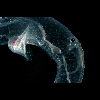 |
Cardiapoda (heteropod mollusc) Is this an elephant with an eye on its trunk? Nope, it's another mollusc. photo by L. Madin, Woods Hole Oceanographic Inst. (WHOI) Sargasso Sea Cruise (10-30 April 2006) |
 |
Phylliroe atlantica
(nudibranch) Nudibranchs are usually benthic. This one was probably taking a ride on a bit of seaweed. That's a gill sticking out at the top. photo by R. Hopcroft, University of Alaska - Fairbanks (UAF) Sargasso Sea Cruise (10-30 April 2006) |
| Baby octopus Only about a centimeter long. photo by R. Hopcroft, University of Alaska - Fairbanks (UAF) Sargasso Sea Cruise (10-30 April 2006) |
|
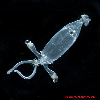 |
Baby squid 'Glass squid' has long eye stalks. photo by R. Hopcroft, University of Alaska - Fairbanks (UAF) Sargasso Sea Cruise (10-30 April 2006) |
| Histioteuthis sp. (squid) 'Cock-eyed squid' photo by L. Madin, Woods Hole Oceanographic Inst. (WHOI) Sargasso Sea Cruise (10-30 April 2006) |
|
| Thysanopods
obtusifrons (euphausiid -'krill') Krill are a primary whale food, escpecially in the high latitudes where dense swarms provide ample nutrition. photo by N. Copley, Woods Hole Oceanographic Inst. (WHOI) Sargasso Sea Cruise (10-30 April 2006) |
|
| Sappharina opalina (copepod) Two egg sacs attached to the tail tell us this is a female. photo by R. Hopcroft, University of Alaska - Fairbanks (UAF) Sargasso Sea Cruise (10-30 April 2006) |
|
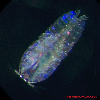 |
Sapphirina metallina (copepod) Like a butterfly, this copepod reflects light to create a rainbow of color. Only the males of this genus are brightly colored; a female Sapphirina is shown above. photo by R. Hopcroft, University of Alaska - Fairbanks (UAF) Sargasso Sea Cruise (10-30 April 2006) |
| Sapphirina angulosa female (copepod) Like a butterfly, this copepod reflects light to create a rainbow of color. photo by R. Hopcroft, University of Alaska - Fairbanks (UAF) Sargasso Sea Cruise (10-30 April 2006) |
|
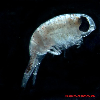 |
Brachyscelus crusculum (amphipod) photo by R. Hopcroft, University of Alaska - Fairbanks (UAF) Sargasso Sea Cruise (10-30 April 2006) |
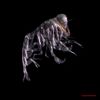 |
Phronima atlantica (amphipod) Lives in a salp body (see below). Large eyes encompassing its entire head and sharp claws give away this animal's predacious lifestyle. Eastern Atlantic, Polarstern cruise 24/1, Nov. 2007 |
| Phronima atlantica (amphipod) This is a top-view of the animal in the previous image surrounded by her young. The transparent barrel is actually the hollowed out body of a salp that serves as a protective house for her and her family. Mom beats her paddled legs to circulate food- and oxygen-containing water through the nest and propel the house. When the young have developed enough to survive on their own, they'll leave the nest. photo by R. Hopcroft, University of Alaska - Fairbanks (UAF) Sargasso Sea Cruise (10-30 April 2006) |
|
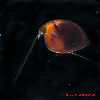 |
Macrocypridina castanea
(ostracod) The dark oval on the shell is actually a clear window in the otherwise pigmented shell through which can be seen facets of the compound eye. photo by R. Hopcroft, University of Alaska - Fairbanks (UAF) Sargasso Sea Cruise (10-30 April 2006) |
| Conchoecilla daphnoides
(ostracod) A strong daily migrator from deep (800-1000m) to the top 200m in high latitudes. photo by R. Hopcroft, University of Alaska - Fairbanks (UAF) Sargasso Sea Cruise (10-30 April 2006) |
|
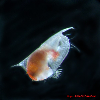 |
Conchoecissa imbricata
(ostracod) Another strong vertical daily migrant, it can control its sinking rate. It also has bioluminescent areas on the front and back ends of its body, perhaps to make it look larger to its predators. photo by R. Hopcroft, University of Alaska - Fairbanks (UAF) Sargasso Sea Cruise (10-30 April 2006) |
| Euconchoecia chierchiae (ostracod with
young) A rainbow of embryos are protected under this female's carapace. The dark eye spot is visible on one. This is the only species of halocyprid that broods its eggs and juveniles. photo by R. Hopcroft, University of Alaska - Fairbanks (UAF) Sargasso Sea Cruise (10-30 April 2006) |
|
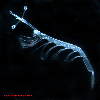 |
Lucifer typus
(decapod) shrimp with long eye stalks. photo by R. Hopcroft, University of Alaska - Fairbanks (UAF) Sargasso Sea Cruise (10-30 April 2006) |
 |
decapod shrimp with a spiral antenna Eastern Atlantic, Polarstern cruise 24/1, Nov. 2007 |
 |
crab megalops. The spines on this larval crab help to keep it afloat. photo by C. Clarke, University of Alaska - Fairbanks (UAF) Eastern Atlantic, Polarstern cruise 24/1, Nov. 2007 |
 |
This gooseneck barnacle spends its life floating on the surface of the ocean, unlike most barnacles that are plankton as larvae but as adults attach to rocks or the undersides of boats.
photo by C. Clarke, University of Alaska - Fairbanks (UAF) Eastern Atlantic, Polarstern cruise 24/1, Nov. 2007 |
 |
Cerianthid anemones are tube dwellers as adult but spend the larval stage in the water column. Eastern Atlantic, Polarstern cruise 24/1, Nov. 2007 |
| Tompteris sp. (polychaete) The long, paddle-like legs of this worm indicate its life in the water column photo by R. Hopcroft, University of Alaska - Fairbanks (UAF) Sargasso Sea Cruise (10-30 April 2006) |
|
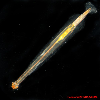 |
Eukrohnia sp.(chaetognath) ' arrow worm' photo by R. Hopcroft, University of Alaska - Fairbanks (UAF) Sargasso Sea Cruise (10-30 April 2006) |
| Colonial_radiolarians Large groups of
single celled animals, each speck is one individual. photo by L. Madin, Woods Hole Oceanographic Inst. (WHOI) Sargasso Sea Cruise (10-30 April 2006) |
|
 |
Radiolarian A colonial sphere of many individual protozoans. See the next image for a closer look. C. de Vargas, Station Biologique de Roscoff Sargasso Sea Cruise (10-30 April 2006) |
| Close-up of Radiolarian colony shown above. The shiney halos are spicules, many floating loose in the mucous sphere. C. de Vargas, Station Biologique de Roscoff Sargasso Sea Cruise (10-30 April 2006) |
|
 |
Globigerinoides
ruber,_pink variety Foraminifera are single-celled animals. They have amoeba-like bodies inside carbonate 'tests' or shells. C. de Vargas, Station Biologique de Roscoff Sargasso Sea Cruise (10-30 April 2006) |
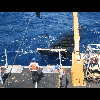 |
MOC10_launch The zooplankton seen on this and other CMarZ pages were mostly taken with large fine mesh multiple net systems. There area up to 10 nets that can be opened and closed on command from the scientist on board the ship. photo by N. Copley, Woods Hole Oceanographic Inst. (WHOI) Sargasso Sea Cruise (10-30 April 2006) |
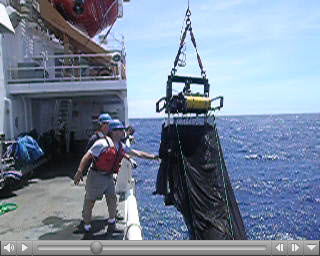 |
- M25_launch_movie (.mov) video by L. Madin, Woods Hole Oceanographic Inst. (WHOI) The quarter-meter MOCNESS has a 64 micron mesh for capturing smaller zooplankton forms such as foraminifera, radiolarians, and younger stages of many types of zooplankton, especially copepods, the world's most abundant type of zooplankton. This 'baby MOC' is only sent to about 200 meters depth. Like the other MOC's , it carries 9 nets that can be opened and closed by sending an electronic signal down the towing wire from the ship. Sargasso Sea Cruise (10-30 April 2006) |
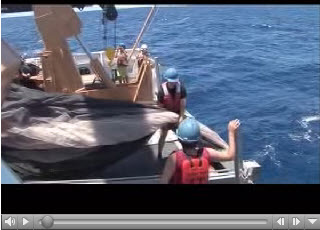 |
- MOC1_launch_and_recovery (.mov) - MOC1_launch_and_recovery (high-resolution .dv) video by L. Madin, Woods Hole Oceanographic Inst. (WHOI) The 1-meter MOCNESS has 335 micron mesh, a standard size for collecting typical zooplankton such as copepods, salps, and pteropods. This is the most commonly used MOC net system. It often samples to about 1000 meters depth. Progress is tracked on a computer on the ship as shown in this clip. The scientist can monitor the depth, water temperature and salinity in order to determine when to signal the nets to open and close. Once the MOCNESS is back on the ship, the cod-end bucket is removed from the net, poured into a pail and quickly taken to a cold room to help keep the animals alive. There, they are transfered to a tray for a snapshot photo record and experts begin examining the catch. Sargasso Sea Cruise (10-30 April 2006) |
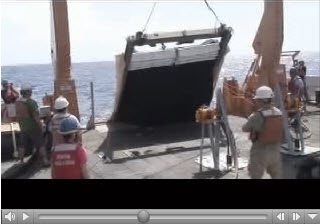 |
- MOC10_launch_RHB06-03 (.mov) - MOC10_launch_RHB06-03 (high-resolution .dv) D. Lindsay, Japan Agency for Marine-Earth Science and Technology (JAMSTEC) The 10-meter MOCNESS has a mouth opening of 10 square meters. Usually, this large net will have 3mm mesh nets to catch larger zooplankton such as krill, shrimp, and deep-sea fish. This particular system has specially designed nets of 335 micron mesh to collect the more typical zooplankton. This system was able to sample all the way to the bottom of the sea, about 5000 meters (over 3 miles!). Because life is sparse in the deep-sea, the large MOC is needed in order to filter huge volumes of water, on the order of a quarter-million cubic meters! Sargasso Sea Cruise (10-30 April 2006) |
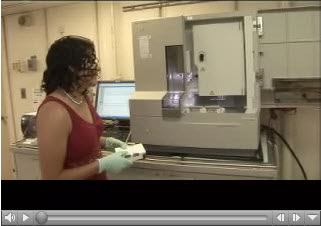 |
- Gene_sequencing_RHB_06-03 (.mov) - Gene_sequencing_RHB_06-03 (high-resolution .dv) viedo by L. Madin, Woods Hole Oceanographic Inst. (WHOI) Once zooplankton are brought on board the ship, expert taxonomists identify the organisms and then the DNA team immediately begins sequencing their genes to create a DNA 'barcode' that could be used in future research to quickly identify these species. This clip shows a tray of vials, each containing a tiny bit of tissue from an animal, being placed into the sequencer and views of the graduate student at the computer with a display of the results of the analysis. Sargasso Sea Cruise (10-30 April 2006) |
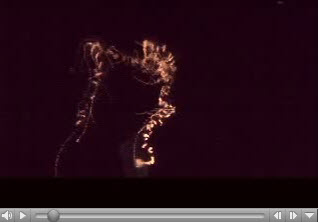 |
- RHB_06-03_zooplankton (.mov) - RHB_06-03_zooplankton (high-resolution .dv) video by L. Madin, Woods Hole Oceanographic Inst. (WHOI) Meat-eating jellies, live zooplankton: 1. siphonophore gracefully moves through the water extending and contracting long stinging tendrils used to capture prey ; 2. ctenophore ('comb jelly') trying to 'catch' a stick offered by zoologist; 3. ctenophores with shimmering 'combs' that are tiny paddle-like blades that propel them through the water. Sargasso Sea Cruise (10-30 April 2006) |
